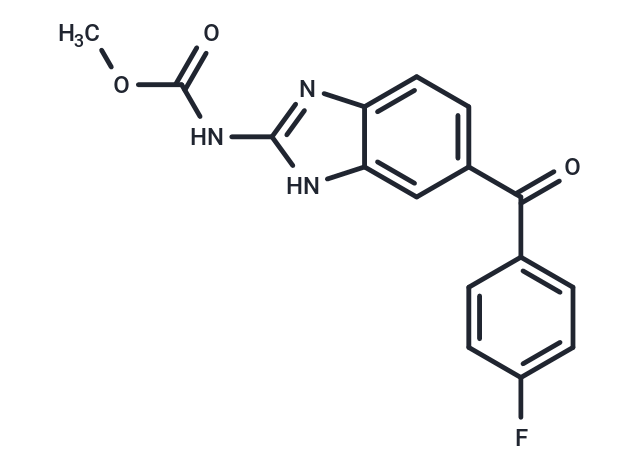Shopping Cart
- Remove All
 Your shopping cart is currently empty
Your shopping cart is currently empty

Flubendazole (Flumoxane) is available OTC in Europe that is an anthelmintic using to treat worm infection in humans.

| Pack Size | Price | Availability | Quantity |
|---|---|---|---|
| 50 mg | $33 | In Stock | |
| 100 mg | $50 | In Stock | |
| 500 mg | $93 | In Stock | |
| 1 mL x 10 mM (in DMSO) | $45 | In Stock |
| Description | Flubendazole (Flumoxane) is available OTC in Europe that is an anthelmintic using to treat worm infection in humans. |
| In vitro | Flubendazole results in morphological changes included contraction of the soma region, the formation of blebs on the tegument, rostellar disorganization, loss of hooks and destruction of microtriches in Echinococcus granulosus. Flubendazole has a bicyclic ring system in which a benzene has been fused to the -4 and -5 positions of the heterocycle (imidazole). Flubendazole and Albendazole show similar potency in affecting rat embryonic development in vitro, inducing retardation of growth and dysmorphogenic effects at concentrations ≥0.5 μg/mL. |
| In vivo | Flubendazole (6.32 mg/kg/day) initially induces an arrest of embryonic development followed by a generalized cell death that leads to 100% embryolethality by gestation day (GD) 12.5. Flubendazole (3.46 mg/kg/day) markedly reduces embryonic development by GD 12.5 without causing cell death. Flubendazole in olive oil causes a statistically significant increase in embryolethality at doses of 7.83 mg/kg per day and higher, with complete resorption in all dams at 31.33 mg/kg per day in rats. Flubendazole treatment causes a slight increase of metyrapone and daunorubicin activities in hepatic as well as intestinal cytosol in birds. Flubendazole treatment leads to statistically significant inhibition of intestinal GST activity. Flubendazole treatment leads to slight but significant inhibition (decrease to 69%) of 7-ethoxyresorufin activity in hepatic microsomes. |
| Alias | NSC 313680, Fluvermal, Flumoxane, Flumoxanal |
| Molecular Weight | 313.28 |
| Formula | C16H12FN3O3 |
| Cas No. | 31430-15-6 |
| Smiles | C(=O)(C=1C=C2C(N=C(NC(OC)=O)N2)=CC1)C3=CC=C(F)C=C3 |
| Relative Density. | 1.444 g/cm3 |
| Storage | keep away from direct sunlight | Powder: -20°C for 3 years | In solvent: -80°C for 1 year | Shipping with blue ice/Shipping at ambient temperature. | |||||||||||||||||||||||||
| Solubility Information | DMSO: 9 mg/mL (28.73 mM), Sonication is recommended. | |||||||||||||||||||||||||
Solution Preparation Table | ||||||||||||||||||||||||||
DMSO
| ||||||||||||||||||||||||||

Copyright © 2015-2025 TargetMol Chemicals Inc. All Rights Reserved.